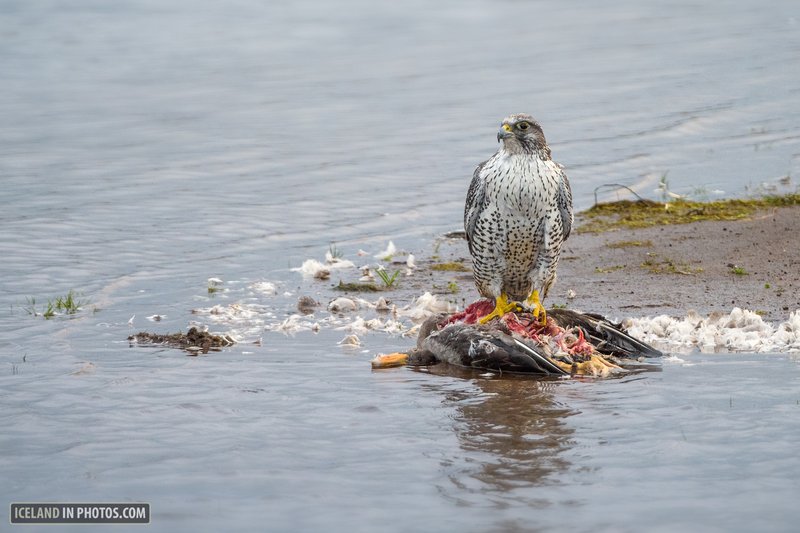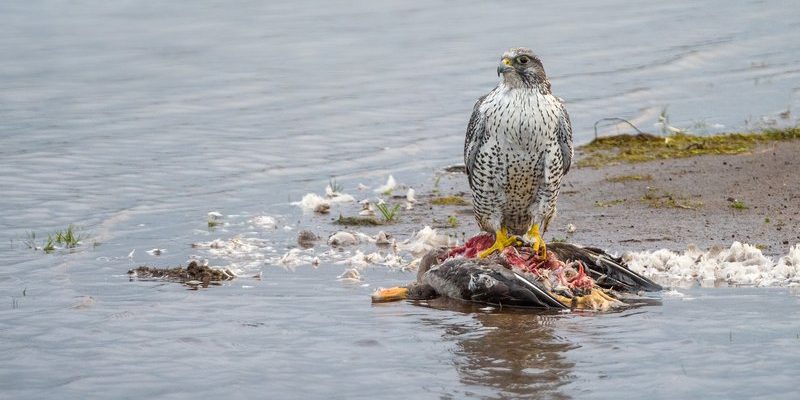
The Gyrfalcon has developed some fascinating hunting strategies to survive in its chilly habitats. Understanding its diet and foraging techniques can give you a deeper appreciation for this remarkable bird. Whether you’re a nature lover, an aspiring ornithologist, or just curious about wildlife, learning about the Gyrfalcon is like unwrapping a gift filled with surprises. So, grab a cozy drink, and let’s dive into the world of the Gyrfalcon’s dinner plans!
Diet of the Gyrfalcon
The Gyrfalcon’s diet is quite diverse, adapting to the prey that is available in its environment. One of its primary food sources is *birds*, particularly smaller species. In fact, Gyrfalcons have been known to feast on seabirds like *ptarmigans* and *guillemots*, making them skilled aerial hunters. Imagine a Gyrfalcon on the hunt, soaring high above the landscape, scanning for movement below. When it spots a potential meal, its keen eyesight and sharp reflexes come into play.
In addition to birds, Gyrfalcons also target *mammals* when the opportunity arises. While they primarily prefer small creatures like *lemmings* or *voles*, they’ll also go after rabbits or even larger birds when they can catch them. It’s pretty remarkable how adaptable these birds are. They have evolved to take advantage of whatever is available, which is key to their survival in the challenging Arctic climate.
Gyrfalcons are also opportunistic feeders, meaning they may take advantage of carrion or dead animals when they find them. This flexibility in diet helps ensure they don’t go hungry, even when their preferred prey is scarce. Think of it as a smart survival tactic—kind of like how we might grab leftovers when we’re not sure what to cook for dinner!
Hunting Techniques
When it comes to hunting, the Gyrfalcon has a few tricks up its sleeve. These birds rely on both their *speed* and *stealth* to catch their prey. They typically hunt alone, which allows them to focus and use their unique skills effectively. Picture a Gyrfalcon perched on a high cliff or tree, patiently waiting for the right moment to strike. This kind of stillness is key; they can spot potential meals from a distance and plan their attack accordingly.
Once they lock onto a target, Gyrfalcons launch into action. They can reach incredible speeds of over 55 miles per hour during their dives, known as *stoops*. This heart-pounding moment when they dive towards their prey is like a roller coaster ride, full of excitement and precision. Their sharp talons are designed for grabbing and holding onto slippery birds or small mammals, ensuring their catch doesn’t get away.
In addition to their speed, Gyrfalcons also use clever strategies to outsmart their prey. They may fly low to the ground, using the terrain to hide and approach unsuspecting birds. When they catch a glimpse of a potential meal, they can change direction swiftly, surprising their target. It’s like a game of chess, where each move counts, and the Gyrfalcon is always on the lookout for the advantage.
Foraging Behavior
Foraging for food isn’t just about outright hunting; it involves a lot of observation and patience, too. Gyrfalcons are keen observers of their environment. They often patrol specific territories, which they know inside and out. This habit allows them to find the best spots for hunting, where the chances of finding food are highest.
During the winter months, food can become scarce, so Gyrfalcons might adapt their foraging strategies. They may travel further distances, sometimes covering several miles in search of food. You might say they have a built-in GPS, guiding them toward the best hunting grounds. This adaptability is essential for survival in their harsh Arctic habitats, where food availability can fluctuate dramatically.
Interestingly, Gyrfalcons are also known to engage in *commensal foraging*. This means they often follow larger predators, like polar bears, to take advantage of leftover scraps. It’s a bit like a clever dinner guest who knows where to find the best food at a gathering! By staying close to these larger animals, Gyrfalcons can find an easy meal without putting in too much effort.
Seasonal Changes in Their Diet
As the seasons change, so too does the Gyrfalcon’s dining menu. In summer, when the Arctic is teeming with life, Gyrfalcons feast on a variety of birds that breed in the region. Their diet might consist of young, inexperienced birds that are easier to catch. With the long summer days providing plenty of light, these falcons are able to hunt more frequently, ensuring they build up energy reserves for the coming winter.
However, as winter sets in and the temperature drops, the availability of food diminishes. During this time, Gyrfalcons often shift their focus to hunting smaller mammals, which may be their only option. They may also take advantage of marine birds that are present along coastlines, altering their hunting patterns to adapt to seasonal changes. It’s a testament to their resourcefulness and ability to thrive in challenging environments.
Hungry for other options, Gyrfalcons may also store food when the hunting is good. They might cache their kills, hiding them under snow or in protected areas. This behavior is a smart way to ensure they have a meal waiting for them when things get tough. Think of it as their version of saving for a rainy day!
Impact of Environmental Factors
Environmental factors can have a significant impact on the Gyrfalcon’s ability to find food. Changes in *climate* and *habitat loss* can disrupt their hunting patterns and overall food availability. For example, warmer temperatures can affect the populations of birds and mammals that Gyrfalcons rely on for sustenance. When their usual dining options decline, these birds must adapt quickly to survive.
Additionally, the rise of human activity in their habitats, such as mining and development, poses risks to their food sources. If prey animals are pushed out of their natural habitats, Gyrfalcons may find it increasingly difficult to hunt. This situation highlights the importance of conservation efforts to protect not only the Gyrfalcon but also the ecosystems they depend on.
Moreover, the availability of food affects Gyrfalcon reproduction. In years when prey is abundant, these birds are more likely to raise successful broods. On the flip side, when food is scarce, they may struggle to raise their young. It’s a delicate balance that emphasizes how interconnected nature truly is.
The Gyrfalcon’s Role In The Ecosystem
Every species plays a role in its ecosystem, and the Gyrfalcon is no exception. As a predator, it helps control the populations of the birds and mammals it preys on. By keeping these populations in check, the Gyrfalcon ensures a balance in the ecosystem, which is vital for overall health. It’s like a natural regulator, maintaining harmony in its Arctic environment.
Moreover, Gyrfalcons are also indicators of environmental health. Because they are at the top of the food chain, any changes in their populations can signal shifts in the ecosystem. For instance, if Gyrfalcon numbers decline, it might indicate that something is wrong, such as habitat degradation or food scarcity. By studying their behavior and numbers, researchers can gain insights into broader environmental issues.
Lastly, the presence of Gyrfalcons often attracts the attention of wildlife enthusiasts and bird watchers. They can be a focal point for conservation efforts, helping to raise awareness about the importance of preserving their habitats. By promoting the conservation of these magnificent birds, we can also help protect the many species that share their ecosystem.
The Gyrfalcon is more than just a stunning bird of prey; it’s a fascinating blend of adaptability, skill, and resilience in the face of challenges. With a diverse diet and clever hunting techniques, these birds have mastered the art of survival in some of the harshest climates on Earth. From their ability to adjust their foraging behavior to seasonal changes to their role in maintaining ecosystem balance, the Gyrfalcon is truly remarkable.
As we continue to learn about and appreciate these incredible creatures, it becomes clear how crucial it is to protect their habitats and the delicate ecosystems they inhabit. So next time you find yourself gazing up at the sky, remember the Gyrfalcon, its sharp eyes scanning the horizon, and the fascinating life it leads. After all, even in the coldest places on Earth, nature finds a way to thrive.

